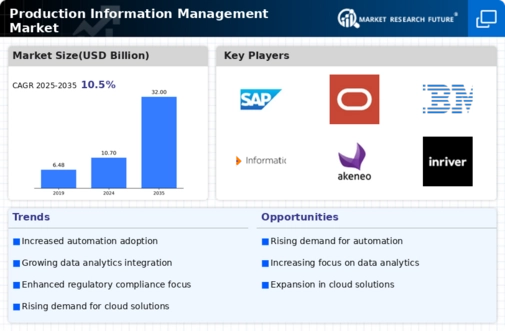Market Analysis
Production Information Management (Global, 2023)
Introduction
Production Information Management (PIM) is becoming an increasingly important part of the landscape of modern business operations. PIM is particularly important in the drive to improve the efficiency and responsiveness of operations in the face of an ever-changing marketplace. PIM systems act as central repositories for product data, ensuring that it is accurate and consistent across all channels and platforms. This capability is essential for companies wishing to deliver a consistent customer experience, enabling them to maintain up-to-date product information, optimize inventory management and facilitate effective collaboration between all involved parties. As the digital revolution continues to transform industries, the demand for effective PIM solutions will continue to rise. This will be driven by the need for organizations to optimize the use of data, improve their operational efficiency and respond to changing customer expectations. PIM solutions are increasingly being integrated with advanced data analysis and machine learning capabilities. This enables companies to gain deeper insights into the performance of their products and the behavior of their customers, enabling them to make more informed strategic decisions and decisions.
PESTLE Analysis
- Political
- In 2023, the Production Information Management market is influenced by various political factors, such as government regulations to increase data security and privacy. The General Data Protection Regulation (GDPR), for example, imposes a fine of up to 20 million euros or four percent of annual turnover on companies that violate the law. This has led to a substantial increase in the implementation of security measures. Similarly, the US government has allocated more than $ 1.5 billion to cybersecurity, which directly influences the production information management market and increases the demand for secure data management solutions.
- Economic
- In 2023, the economy is increasingly dominated by digital transformation. The total spending on digital technology is expected to be $ 2 trillion. It is driven by the need for greater efficiency and the importance of data-driven decision-making, which is crucial to the management of production information. The unemployment rate in the technology industry has been stable at about 3.5%. This indicates a strong job market and a need for more data management personnel, which will increase the overall capabilities of the industry.
- Social
- In 2023, there is a growing demand for transparency and accountability in the production process. Surveys show that 75% of consumers prefer to buy from companies that are transparent about their production practices. This shift in customer behavior is forcing companies to adopt more advanced information systems that monitor and report on production and supply chain activities. This creates customer trust and loyalty. Moreover, the increasing emphasis on CSR is driving companies to invest in sustainable production practices.
- Technological
- IT DISRUPTIVES ARE ALSO CHANGING THE MARKET IN 2023. Artificial intelligence and machine learning are expected to further improve the ability to analyze data, and it is expected that up to 40 percent of companies will use artificial intelligence in their production processes. Cloud platforms are also increasing, and up to 60 percent of companies will use cloud services to manage data, which enables real-time access and collaboration between teams and thus increases efficiency.
- Legal
- Legal factors are increasingly determining the conditions for the production of information, especially the new data protection regulations. The Californian Data Privacy Act, which comes into force in 2023, imposes fines of up to $ 7,500 per infraction. This forces companies to ensure compliance with strict data protection guidelines. In addition, the growing number of intellectual property rights for data ownership makes it necessary to rethink the data management strategies in order to avoid future lawsuits and thus to make the necessary investment in secure production information systems.
- Environmental
- The production information market is in 2023 increasingly influenced by considerations of the environment. By now, a great many companies have undertaken to reduce their carbon footprint. Eighty per cent of the companies have declared their commitment to the concept of sustainable development. In the meantime, the implementation of eco-friendly production methods has led to the establishment of information systems that monitor the metric indicators of the environment. The stricter regulations of the authorities, which impose fines of up to fifty thousand dollars for non-compliance, also lead to an increased investment in sustainable production information systems.
Porter's Five Forces
- Threat of New Entrants
- The market for Production Information Management has a moderate barrier to entry due to the need for specialized knowledge and technology. But the growing demand for more efficient information management solutions also attracts new entrants. Brand-name companies with a high degree of brand awareness and customer loyalty, however, represent a challenge for new entrants.
- Bargaining Power of Suppliers
- Suppliers in the PIM market have low bargaining power because there are many suppliers and software manufacturers. Consequently, companies have a high degree of freedom in choosing between different solutions. The ease with which companies can change suppliers gives them bargaining power.
- Bargaining Power of Buyers
- There are high bargaining powers in the market for the buyers because of the great choice of products. There are many sellers offering similar products and services, and therefore buyers can easily compare the offerings and bargain. In addition, the growing demand for individual solutions gives buyers a say in product design and price.
- Threat of Substitutes
- The threat of substitutes on the market for Production Information Management is moderate. There are several alternative methods of managing production information, such as manual processes or less sophisticated software, but the efficiency and effectiveness of specialized solutions make them preferable. Nevertheless, advances in technology could lead to the emergence of new substitutes.
- Competitive Rivalry
- The competition in the PIM market is high and the number of companies is considerable. In order to be able to distinguish themselves from their competitors, companies are constantly innovating and improving their products. The need for continuous improvement of the service also increases the competition, which in turn leads to more aggressive marketing and price strategies.
SWOT Analysis
Strengths
- Increased efficiency in data management processes.
- Enhanced collaboration across departments and teams.
- Ability to integrate with various production systems and technologies.
- Improved data accuracy and real-time reporting capabilities.
Weaknesses
- High initial implementation costs for businesses.
- Complexity in training staff to use new systems effectively.
- Potential resistance to change from employees accustomed to traditional methods.
- Dependence on technology may lead to vulnerabilities in data security.
Opportunities
- Growing demand for digital transformation in manufacturing sectors.
- Expansion into emerging markets with increasing production needs.
- Development of AI and machine learning capabilities to enhance data analytics.
- Partnerships with technology providers to offer integrated solutions.
Threats
- Rapid technological advancements may outpace current solutions.
- Intense competition from established software providers.
- Economic downturns affecting production budgets and investments.
- Regulatory changes impacting data management practices.
Summary
Production Information Management is characterized by its strengths in terms of efficiency and collaboration, but faces challenges such as high costs and resistance from employees. Opportunities for growth come from digital transformation and technological advances, while competition and economic uncertainty represent risks. To remain competitive, companies must take advantage of strengths and opportunities and deal with weaknesses and threats.









Leave a Comment